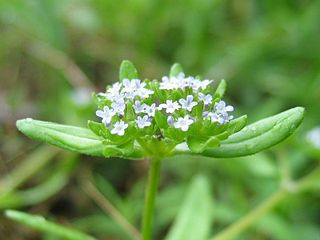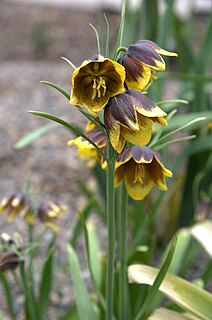
Nepeta is a genus of flowering plants in the family Lamiaceae. The genus name is reportedly in reference to Nepete, an ancient Etruscan city. There are about 250 species.

Clover or trefoil are common names for plants of the genus Trifolium, consisting of about 300 species of flowering plants in the legume or pea family Fabaceae originating in Europe. The genus has a cosmopolitan distribution with highest diversity in the temperate Northern Hemisphere, but many species also occur in South America and Africa, including at high altitudes on mountains in the tropics. They are small annual, biennial, or short-lived perennial herbaceous plants, typically growing up to 30 cm tall. The clover is the color of evergreen. The leaves are trifoliate, cinquefoil, or septfoil, with stipules adnate to the leaf-stalk, and heads or dense spikes of small red, purple, white, or yellow flowers; the small, few-seeded pods are enclosed in the calyx. Other closely related genera often called clovers include Melilotus and Medicago.

Medicago is a genus of flowering plants, commonly known as medick or burclover, in the legume family (Fabaceae). It contains at least 87 species and is distributed mainly around the Mediterranean basin. The best-known member of the genus is alfalfa, an important forage crop, and the genus name is based on the Latin name for that plant, medica, from Greek: μηδική (πόα) Median (grass). Most members of the genus are low, creeping herbs, resembling clover, but with burs. However, alfalfa grows to a height of 1 meter, and tree medick is a shrub. Members of the genus are known to produce bioactive compounds such as medicarpin and medicagenic acid. Chromosome numbers in Medicago range from 2n = 14 to 48.

Centaurea is a genus of between 350 and 600 species of herbaceous thistle-like flowering plants in the family Asteraceae. Members of the genus are found only north of the equator, mostly in the Eastern Hemisphere; the Middle East and surrounding regions are particularly species-rich. In the western United States, yellow starthistles are an invasive species. Around the year 1850, seeds from the plant had arrived to the state of California. It is believed that those seeds came from South America.

Colchicum is a genus of perennial flowering plants containing around 160 species which grow from bulb-like corms. It is a member of the botanical family Colchicaceae, and is native to West Asia, Europe, parts of the Mediterranean coast, down the East African coast to South Africa and the Western Cape. In this genus, the ovary of the flower is underground. As a consequence, the styles are extremely long in proportion, often more than 10 cm (4 in). All species in the genus are toxic.

Verbascum, common name mullein, is a genus of about 360 species of flowering plants in the figwort family Scrophulariaceae. They are native to Europe and Asia, with the highest species diversity in the Mediterranean.

Lotus, a latinization of Greek lōtos (λωτός), is a genus of flowering plants that includes most bird's-foot trefoils and deervetches and contains many dozens of species distributed worldwide. Depending on the taxonomic authority, roughly between 70 and 150 are accepted. Lotus is a genus of legumes and its members are adapted to a wide range of habitats, from coastal environments to high altitudes.

Isatis is a genus of flowering plants in the family Brassicaceae, native to the Mediterranean region east to central Asia. The genus includes woad. Due to their extremely variable morphology, the Asian species in particular are difficult to determine; the only reliable diagnostic feature is the ripe fruit. They are (usually) biennial or perennial herbaceous plants, often bluish and hairless or downy hairy with the upright stem branched.

Trigonella is a genus from the family Fabaceae. The best known member is the herb fenugreek. Members of the genus occur naturally in the Canary Islands, southern Europe, non‑tropical Africa, western and central Asia, the Indian subcontinent, and Australia.

Umbilicus is a genus of over ninety species of flowering plants in the family Crassulaceae. Many of its species have been given synonyms under different genera such as Rosularia, Cotyledon, and Chiastophyllum. However, those that remain in Umbilicus are listed below:

Acanthus is a genus of about 30 species of flowering plants in the family Acanthaceae, native to tropical and warm temperate regions, with the highest species diversity in the Mediterranean Basin and Asia. This flowering plant is nectar producing and is susceptible to predation by butterflies, such as Anartia fatima, and other nectar feeding organisms. Common names include Acanthus and Bear's breeches. The generic name derives from the Greek term ἄκανθος (akanthos) for Acanthus mollis, a plant that was commonly imitated in Corinthian capitals.

Asperula, commonly known as woodruff, is a genus of flowering plants in the family Rubiaceae. It contains about 195 species and has a wide distribution area from Europe, northern Africa, temperate and subtropical Asia to Australasia.

Hedysarum (sweetvetch) is a genus of the botanical family Fabaceae, consisting of about 200 species of annual or perennial herbs in Asia, Europe, North Africa, and North America.
Hymenocrater is a genus of plants from the mint family. It is native to central and southwestern Asia from Turkey to Turkmenistan and Pakistan.
- Hymenocrater adenothrixRech.f. - Afghanistan
- Hymenocrater altimuranusRech.f. - Afghanistan
- Hymenocrater bituminosusFisch. & C.A.Mey. - Turkey, Iran, Caucasus
- Hymenocrater calycinus(Boiss.) Benth. - Turkmenistan, Iran
- Hymenocrater elegansBunge - Turkmenistan, Iran
- Hymenocrater incanusBunge - Iran
- Hymenocrater inciaidentatusBoriss. - Turkmenistan
- Hymenocrater longiflorusBenth. - Iran, Iraq
- Hymenocrater oxyodontusRech.f. - Iran
- Hymenocrater platystegiusRech.f. - Iran
- Hymenocrater sessilifoliusBenth. - Afghanistan, Iran, Pakistan
- Hymenocrater yazdianusRech.f. - Iran

Valerianella is a genus of plant in family Caprifoliaceae. Many plants of this genus are known by the common name corn salad or cornsalad, although that name most often refers to Valerianella locusta.

Zygophyllum is the type genus of the flowering plant family Zygophyllaceae. The generic name is derived from the Greek words ζυγόν (zygon), meaning "double", and φυλλον (phyllon), meaning "leaf". It refers to the leaves, each of which have two leaflets. The genus is distributed in arid and semi-arid regions of Africa, the Mediterranean Basin, central Asia and Australia.

Rosularia is a small genus of the family Crassulaceae. It includes about 28-35 species from Europe, the Himalayas, and northern Africa. It is a larval host for the butterfly Parnassius apollonius.

Fritillaria reuteri is a perennial herbaceous bulbous plant, distributed in Turkey and Iran. It is a species in the genus Fritillaria, in the family Liliaceae. It is placed in the subgenus Fritillaria.
















